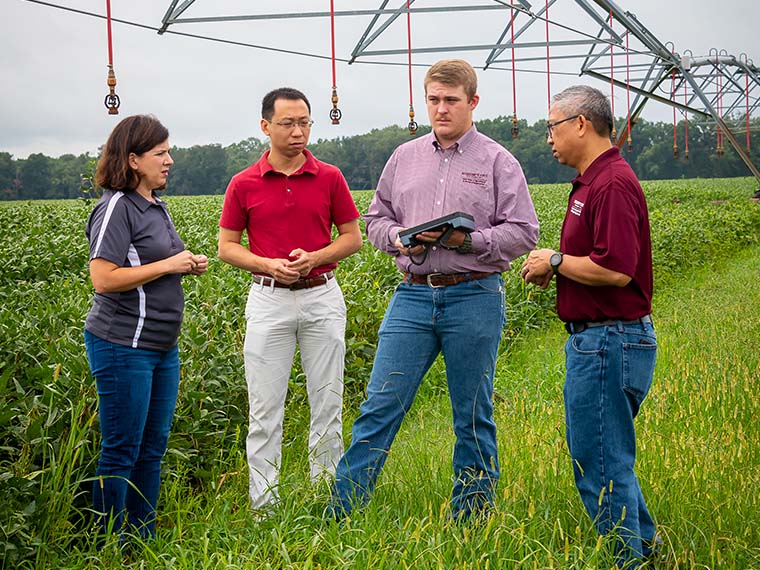The information presented on this page may be dated. It may refer to situations which have changed or people who are no longer affiliated with the university. It is archived as part of Mississippi State University's history.
In Mississippi alone, over two million acres are harvested yearly for soybean production, bringing in a $1.49 billion dollar value of production in 2021. However, growing crops from seed to harvest is no easy task. There are many environmental factors that prove stressful and costly to producers. One factor is irrigating crops at the right time with the right amount of water. If fields experience a lack of water throughout the growing season, it can be detrimental to crop growth. Many farmers turn to supplemental irrigation, but find that uniformly irrigating the whole field is costly and ineffective. Mississippi Agricultural and Forestry Experiment Station (MAFES) researchers and MSU Extension specialists are working to create cost-efficient solutions to reduce water waste and increase production value for farmers.
This research project started several years ago when Dr. Mary Love Tagert, associate extension professor, and Dr. Joel Paz, professor, both in the Department of Agricultural and Biological Engineering, received funding to examine in-field variability of soil moisture over time. Surveying a soybean field for over four years in Northeast Mississippi, the researchers found that soil moisture levels were highly variable over the field. They began searching for solutions that would provide the precise amount of irrigation needed for unique field areas rather than applying the same irrigation rates across the entire field.
"Working with a producer in Brooksville, Mississippi, we set up a grid of soil moisture sensors to evaluate spatiotemporal variability in his field," said Tagert. "We then examined what factors affect whole-field moisture and saw that there was a difference in field elevation."
Spatiotemporal variability describes the changes occurring over the field throughout the growing season. Tagert and Paz used the spatiotemporal soil moisture data to create maps of the field's soil moisture levels to determine the new irrigation strategies. In-field areas with higher elevations required more irrigation than low elevation areas which receive more water due to gravitational forces. Tagert and Paz implemented a variable-rate irrigation system which is a precision agriculture practice that changes the revolution speed of a center pivot to regulate what areas of the field receive more or less surface water.
"We install Watermark sensors at multiple depths to get accurate data of the soil's water content," said Paz. "Because of the phenomenal improvements in technology, farmers can schedule irrigations based off the sensor reading of their fields."
Customizing irrigation for variable rate-based sensor readings, the team pinpointed which areas needed more irrigation. They then programmed the center pivot to slow revolution speed in the specified areas. This longer exposure provided the area with more water while not overwatering other areas in the pivot rotation. Integrating this type of sector-control variable rate irrigation is shown to be time-efficient and inexpensive. Producers with late-model center pivots need only program their revolution speed to accommodate the needs of the pie-shaped zones receiving irrigation. Tagert and Paz are confident that implementing this strategy will help save soybean producers' water and energy, particularly in drought years where efficient irrigation is crucial for crop production.
"Groundwater is not really a viable irrigation option in northeast Mississippi, so the main source of water for irrigation is surface water," Tagert said. "I also hope that this project will provide more justification for federal cost assistance programs for irrigation-related needs for farmers in the northeast part of the state."
The team was unable to collect data during the 2021 growing season due to a lack of need for supplemental irrigation and resumed studies in 2022. Now Tagert and Paz are collaborating with colleagues in the Department of Agricultural Economics to evaluate the economic benefit of adopting variable rate irrigation. Once the economic assessment is complete, the team will assess the potential need for more educational programs for variable rate irrigation in the area. After concluding the geospatial inventory, Tagert will continue sharing the data findings through organized conferences, Extension publications, and producer meetings.
"I'm excited for the opportunity to help farmers save water without making additional financial investments," said Tagert. "If they already have the pivot with a compatible control panel, then they can implement sector-control precision irrigation without any additional cost."
This research is funded by the Mississippi Soybean Promotion Board. In addition to Tagert and Paz, the team includes Dr. Himmy Lo, assistant extension and research professor, Dr. Xiaofei Li, assistant professor, and Zeb Green, undergraduate student.

